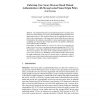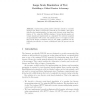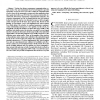36 search results - page 2 / 8 » Browser-Based Attacks on Tor |
ACISP
2008
Springer
13 years 11 months ago
2008
Springer
The standard solution for mutual authentication between human users and servers on the Internet is to execute a TLS handshake during which the server authenticates using a X.509 ce...
FC
2009
Springer
13 years 11 months ago
2009
Springer
Abstract. Tor is currently one of the more popular systems for anonymizing near real-time communications on the Internet. Recently, Borisov et al. proposed a denial of service base...
ASIAN
2007
Springer
13 years 11 months ago
2007
Springer
Implementing global passive adversary attacks on currently deployed low latency anonymous networks is not feasible. This paper describes the implementation of a large scale, discre...
SP
2006
IEEE
13 years 10 months ago
2006
IEEE
Hidden services were deployed on the Tor anonymous communication network in 2004. Announced properties include server resistance to distributed DoS. Both the EFF and Reporters Wit...
TON
2012
11 years 7 months ago
2012
Abstract—Various low-latency anonymous communication systems such as Tor and Anonymizer have been designed to provide anonymity service for users. In order to hide the communicat...



